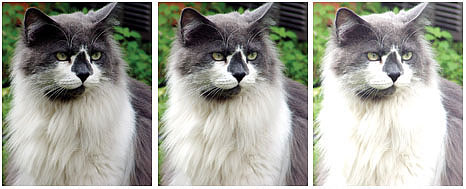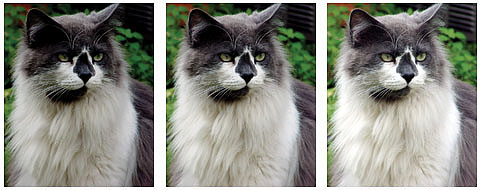Fine Tune Your Exposures With “Smart” Bracketing
by Arthur H. Bleich–
Most digital cameras have an auto-bracketing feature that allows three or more images to be shot manually or automatically in rapid succession, each at a different exposure. The first picture is exposed at what the camera’s light meter determines to be correct, followed by an under-exposed image and then another that’s over-exposed. You can preset the amount of exposure difference between shots and sometimes even choose a different order, for example, “under-correct-over” or “over-correct-under.”

Standard Bracketing Is Good––With standard bracketing chosen for three shots, in increments of one exposure value (EV), the camera will shoot what it considers a correctly exposed image (center), then one under-exposed (left), and the third overexposed (right). The overexposed shot is a throwaway because highlight detail (in the fur) is gone and cannot be retrieved.
When film dominated photography, pros always bracketed because they weren’t able to see how their pictures turned out until they were processed; if the exposure wasn’t correct, the shot would be unusable. Bracketing had to be done manually– the aperture or shutter speed was reset by hand between shots, no easy feat. As cameras became more sophisticated, automatic bracketing was added.
Bracketing is still a valuable tool for digital cameras because it’s hard to check exposure accurately on the camera’s monitor. Light falling on the monitor or one that’s been set brighter or dimmer for easier viewing can make it impossible to determine if the exposure is on the nose. The only way to tell for sure is to check a histogram –if your camera has that feature– but that can interrupt the flow of shooting.
The best times to bracket are under extremely bright or low lighting conditions, although some photographers do it routinely even with normal lighting. Under good lighting, the overexposed bracketed shot will usually be wasted– the highlights may be way too light and the picture unusable. That’s the time to use “smart” bracketing that will make one shot at the camera’s suggested exposure, then one underexposed, and a second one underexposed even more.
How do you set this up? Simply use your camera’s Exposure Compensation feature to move the pointer to the minus side. Let’s say you select minus one, a full exposure value. The “correct” exposure normally chosen by your camera will now be underexposed by one stop. So when your camera goes through the bracketing routine, the sequence will remain the same (“correct,” “under,” and “over”) but your exposures will really be “under by one stop,” “under by two stops,” and “correct.” You’ve now eliminated the usually-wasted overexposed picture in the normal bracketing sequence and have begun to bend bracketing to your will.

Smart Bracketing Is Better––Setting Exposure Compensation to –1 here’s what smart bracketing produces. The “correct” exposure (center) is now underexposed by one exposure value (EV) compared to what it normally would be if –1 exposure compensation had not been used. The overexposed photo (right) now has the same exposure as the “correct” one did in the standard bracketing series. The picture on the left is now underexposed by two exposure values. By using smart bracketing, all of these images are usable, depending on the effect you want.
Of course, you can also go the other way, by setting the Exposure Compensation to overexpose (the plus side), which would give you one picture overexposed, another “correctly” exposed and a third overexposed even more. That would be a good way to go in super-bright scenes at the beach or in snow country, where your camera’s light meter can easily be fooled by the extreme brightness and underexposes, making most pictures look too dark and turning sand and snow into muddy gray.
Once you learn how to smart-bracket by combining exposure compensation adjustments along with your camera’s auto-bracketing feature, you’ll begin to capture more pictures that are usable and you won’t always end up with one in the series that usually turns out to be a throwaway.
Original Publication Date: September 18, 2014
Article Last updated: September 18, 2014
Related Posts and Information
Categories
About Photographers
Announcements
Back to Basics
Books and Videos
Cards and Calendars
Commentary
Contests
Displaying Images
Editing for Print
Events
Favorite Photo Locations
Featured Software
Free Stuff
Handy Hardware
How-To-Do-It
Imaging
Inks and Papers
Marketing Images
Monitors
Odds and Ends
Photo Gear and Services
Photo History
Photography
Printer Reviews
Printing
Printing Project Ideas
Red River Paper
Red River Paper Pro
RRP Products
Scanners and Scanning
Success on Paper
Techniques
Techniques
Tips and Tricks
Webinars
Words from the Web
Workshops and Exhibits
all
Archives
January, 2025
December, 2024
November, 2024
October, 2024
September, 2024
August, 2024
July, 2024
June, 2024
May, 2024
more archive dates
archive article list




